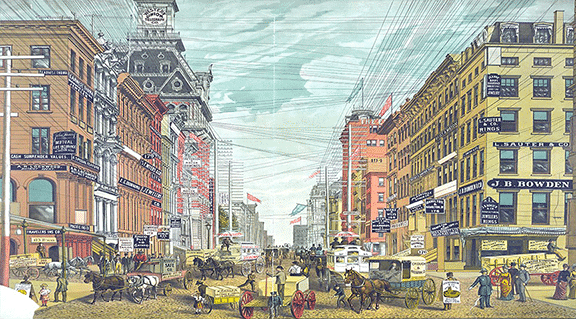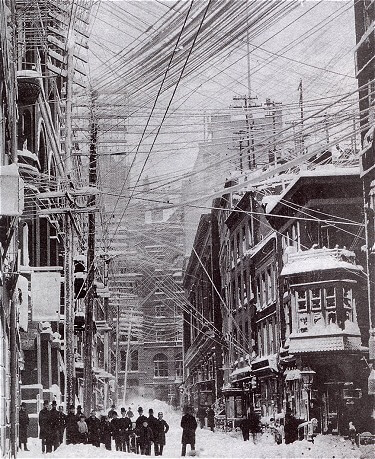Evaluating a Historic Conduit for Upgrade
Polywater® Friction Table Helps in Assessing Usability of Fiber Conduit Pipe.

Overview
Not so long ago, urban streets were festooned with hundreds of overhead electrical and telephone wires. Depending on one’s viewpoint, they represented progress, abstract beauty, or opportunities for injury during a storm. Ultimately, the prevailing view was that these wires were ugly and dangerous, initiating the quest for ways to keep them out of sight and under the ground without damaging the wires themselves. An early solution was conduit pipes.
The early years of fiber conduit pipes*
One of the first pipes used for underground cables was a fiber conduit, developed in the late 1800s. It is essentially a wood pulp fiber combined with water-resistant adhesive and impregnated with liquefied coal tar pitch. This new conduit design was lightweight, strong, corrosion-proof, and economical. The first known use of the fiber conduit pipe was for water transmission in the Boston area. The 1.5-mile pipeline stayed in service for more than 60 years from 1865 to 1927.
| Related Content: FAQ – Cable Pulling, Lubrication, and Tension |
In 1893, Stephen Bradley, the owner of electric power generating plants, founded the first fiber conduit company, which flourished for 40 years. The conduit was used for running electrical lines throughout new structures, including the New York Park Avenue Tower, the Empire State Building, and other skyscrapers in New York and other cities. Demand for the fiber conduit grew during World War II when it was also used in construction of new airfields and military bases.

The market for fiber conduit grew as subways were built throughout eastern seaboard cities. The conduit contained electrical, telephone, telegraph, and other wiring within the subway tunnels. Other uses included duct banks for electrical wires under streets and roads and along railroad rights-of-way. Efforts to use the conduit to carry wastewater away from oil drilling operations were not successful, but its uses as sewer pipes and drain tiles were. Demand for fiber conduit pipe peaked during the 1950s and 1960s with 500 tons of pipe shipped weekly throughout the US. Companies in Canada and Europe also manufactured fiber conduit sewer pipes from the 1950s through the 1970s.
When polyvinyl chloride (PVC) pipe was introduced in the late 1960s, it proved to be cheaper for sewer and drain applications and led to closing of fiber conduit pipe factories. Yet, millions and millions of feet of the fiber conduit are still in use within buildings, under streets and roads, in subway systems, and along railroad tracks. It is also still used to connect houses to sewer systems and in drain fields throughout the country. This conduit design proved to have longevity and versatility, although tree roots have been found to wrap themselves around pipes, causing deformation and crushing. Dry soil, grass, and plant roots are also known to degrade the pipes. It may be time to replace these conduits.
* Historical information from “Coal Tar Impregnated Wood Fibre Pipe” by Jon C. Schladweiler, historian, AZ Water.
The challenge of old duct, new installation
Indeed, as utility companies upgrade their electrical systems and encounter older systems, they generally like to plan for replacement. Companies, however, also face an increasingly crowded, underground system of cables and conduits with difficult permit requirements and work zone access. Where possible, reuse of existing conduit structures is preferred. Can new cables be installed in old conduits? In this case study, design engineers for a power company turned to Polywater for insight on whether they could use an existing tar-impregnated fiber conduit in one of their upgrade projects. They asked Polywater to test the coefficient of friction using the new cable on a reclaimed piece of conduit, believed to be more than 50 years old. Polywater tested multiple lubricants to determine the optimum product to facilitate the new cable installation.
| Related Content: Coefficient of Friction in Cable Pulling — Part 1 |
In this case study, design engineers for a power company turned to Polywater for insight on whether they could use an existing tar-impregnated fiber conduit in one of their upgrade projects. They asked Polywater to test the coefficient of friction using the new cable on a reclaimed piece of conduit, believed to be more than 50 years old. Polywater tested multiple lubricants to determine the optimum product to facilitate the new cable installation.
The Solution
Using the friction table to determine COF
Polywater used its Friction Table to determine the coefficient of friction (COF), using several Polywater lubricants.
A 115 KV cable with polyethylene jacket that would be used in this upgrade was provided, as well as the reclaimed conduit. Polywater has a long history of collecting friction data from testing real cables and conduits using Polywater lubricants. This has resulted in an extensive COF database and an ongoing relationship with cable manufacturers and design engineers to better predict cable performance and cable pull tensions.
| Related Content: Planning Cabling Projects Improves Success and Safety |
Polywater lubricants found to lower COF
The historic conduit had accumulated a layer of grime that increased the friction and produced relatively high COF. Cleaning the duct lowered the friction by about 30 percent and adding Polywater lubricants lowered the friction by another 30 to 50 percent. Polywater LZ, Polywater J, and Polywater NN lubricants were all tested, producing COF values ranging from 0.15 to 0.20. Polywater NN was the most effective and was recommended for this installation.
Good work practices, tension prediction, and proper lubrication techniques allowed for successful cable installation in the historic conduit. Our lab team was able to provide reliable test results and confidence to the project design engineers for this upgrade project.
| Related Content: The Polywater® Friction Table: Personal Perspectives |
Have any questions?
©2020 American Polywater Corporation, Evaluating a Historic Conduit for Upgrade